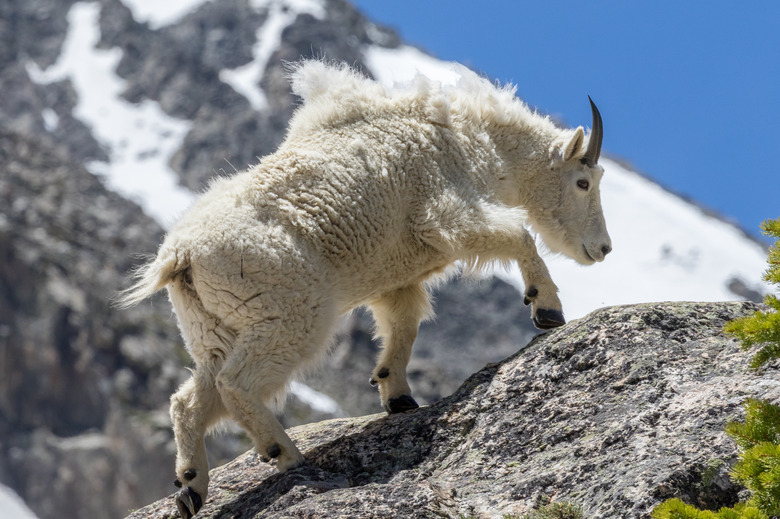Adaptations Of Plants & Animals To Mountains
The mountains can be a barrier to both plants and animals due to rapidly changing ecosystems, harsh climates, scarce food and treacherous climbing. For this reason, either side of any given mountain range can be home to entirely different plant and animal species. However, plants and animals that do reside in the mountains have adapted in many ways to survive in harsh conditions. The most significant adaptations of plants and animals are seen at higher elevations, as these areas offer the most extreme conditions.
Low Growth
Low Growth
Trees begin to thin as you travel higher in the mountain biome. Tree cannot grow at higher elevations due to harsh winds and extreme climates. The area at which trees cease to grow in the mountain range is known as the timberline. Plants that can survive above 3,000 feet include sparse grasses and alpine perennials, which have adapted to extreme cold and heat, strong sun, heavy winds and fluctuations between arid and damp condition. These plants grow very low to the ground, allowing them to stay below the snow pack in winter months so they are not pelted with ice and snow.
Food, Moisture and Energy Storage
Food, Moisture and Energy Storage
Spring and summer in the mountains is a very short period, between late June and September, after which frosts begin and mountain ranges are covered with snow. For this reason, plants have adapted to store food, moisture and energy. Plants at higher elevations have stems or rhizomes which extend deep beneath the soil's surface. These stems allow food storage so plants can begin immediate growth in the spring, without having to wait for the soil to thaw to provide water and nutrients.
Other plants have formed a waxy substance on their leaves that seals moisture in, due to the fact that thin soil in the mountains cannot retain moisture. The mountains are home to many evergreen trees and plants which keep their leaves throughout the winter; therefore they don't require energy and nutrients to develop new leaves during the short growing season.
Saving Energy
Saving Energy
Animals in the mountains have also adapted to save energy during the harsh winter months. Some animals, such as the alpine marmot, hibernate nine months of the year to save energy and avoid harsh winter conditions. Other animals reduce their activity level, saving their energy only to look for food. Mountain goats have adapted to eat almost any plant substance the mountain range provides. This keeps them from having to travel long distances in search of food and, therefore, saves them energy.
Climbing and Elevation
Climbing and Elevation
Mountain dwelling animals have adapted physically, making them able to navigate the rocky, steep, jagged terrain. The ibex has specialized hooves, composed of a hard outer edge and a soft center, that allow them to grip rocks and climb steep hills and rocks. Animals living in the mountains have also developed thick coats of fur that protect them from the cold as they travel higher in elevation. Higher elevations also mean less oxygen. Yaks living in the Himalayas have developed larger hearts and lungs, which allow them to live 18,000 feet above sea level where the air is thin.
Cite This Article
MLA
Maier, Casandra. "Adaptations Of Plants & Animals To Mountains" sciencing.com, https://www.sciencing.com/adaptations-plants-animals-mountains-8417296/. 24 April 2018.
APA
Maier, Casandra. (2018, April 24). Adaptations Of Plants & Animals To Mountains. sciencing.com. Retrieved from https://www.sciencing.com/adaptations-plants-animals-mountains-8417296/
Chicago
Maier, Casandra. Adaptations Of Plants & Animals To Mountains last modified March 24, 2022. https://www.sciencing.com/adaptations-plants-animals-mountains-8417296/
